Human Resource Management Report for Home Cozy: Analysis
VerifiedAdded on 2021/11/17
|24
|4469
|26
Report
AI Summary
This report, prepared by a student, delves into various facets of Human Resource Management (HRM) within the context of a company named Home Cozy. The report commences by outlining strategic goals and how HRM initiatives can contribute to their achievement, emphasizing innovation, recruitment, and employee development. It then examines the recruitment process, highlighting factors like experience, potential, hard skills, and cultural fit, alongside the importance of induction programs. The report further analyzes performance appraisal systems, discussing their advantages in terms of motivation, self-development, and identifying underperformers. Additionally, it explores performance-based pay structures and succession planning strategies. The report also touches on motivational theories, organizational culture, and communication strategies, concluding with an overview of an HRM-related problem concerning employee retention. The report provides a comprehensive analysis of HRM practices, offering valuable insights into the effective management of human capital within an organization.
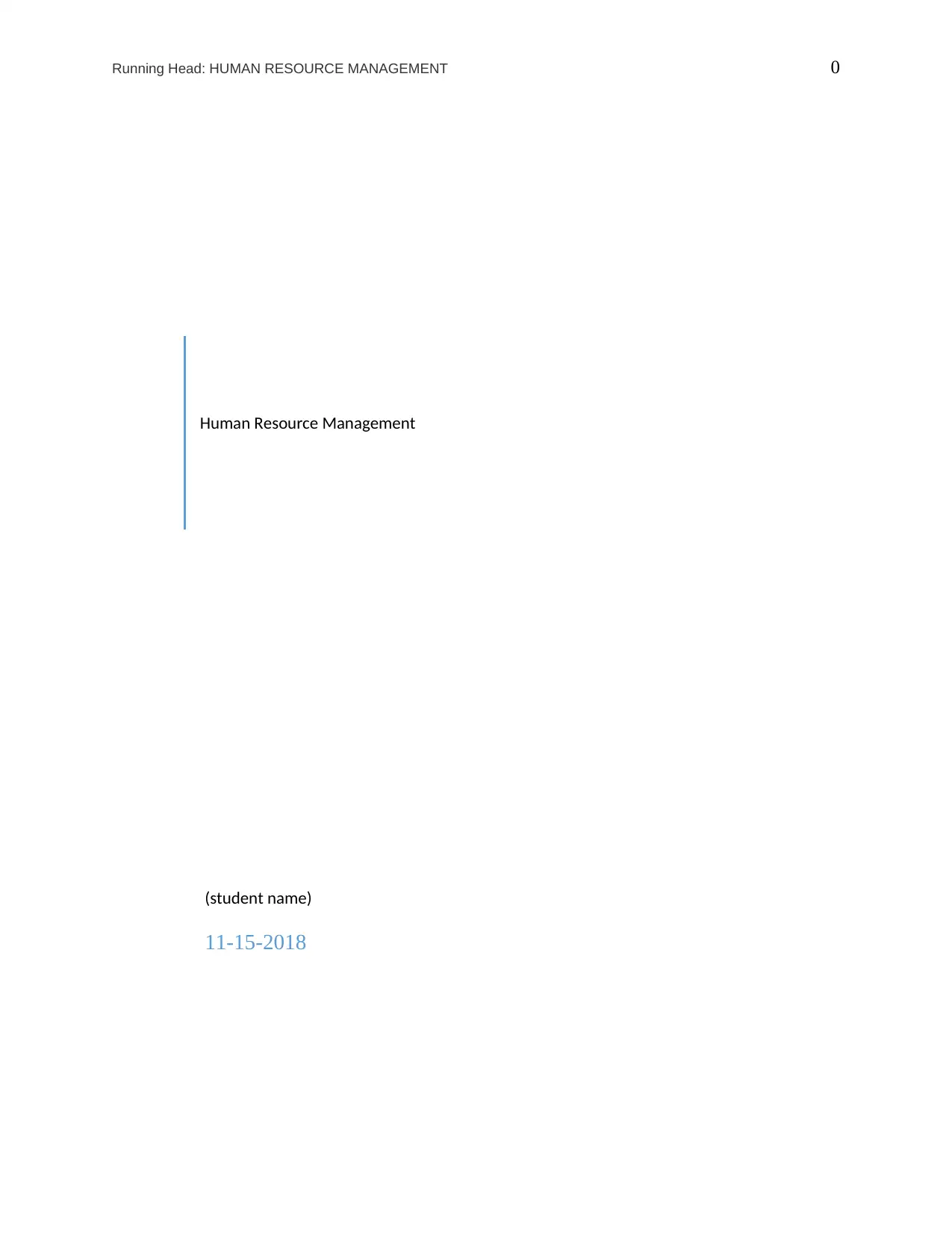
Running Head: HUMAN RESOURCE MANAGEMENT 0
Human Resource Management
(student name)
11-15-2018
Human Resource Management
(student name)
11-15-2018
Paraphrase This Document
Need a fresh take? Get an instant paraphrase of this document with our AI Paraphraser
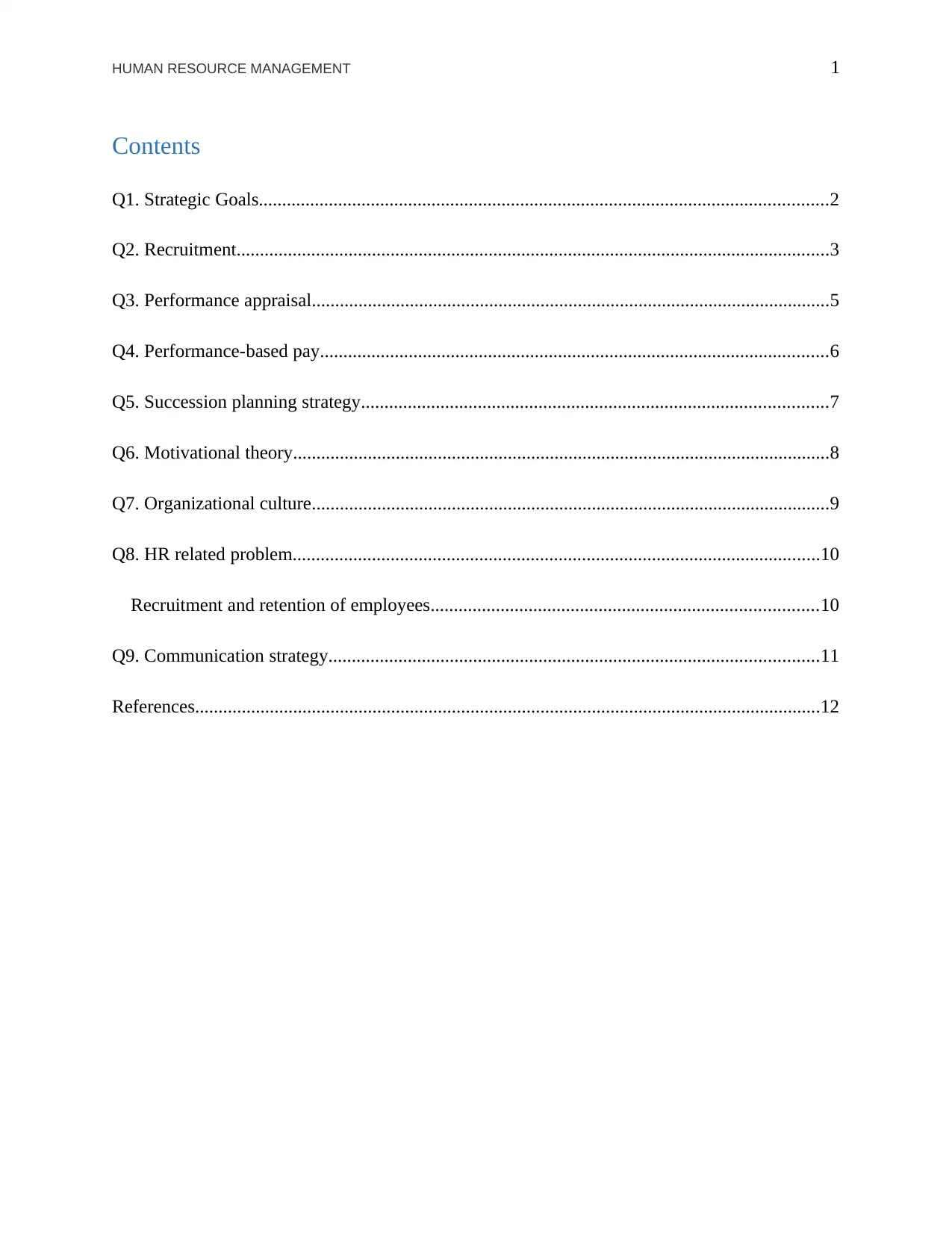
HUMAN RESOURCE MANAGEMENT 1
Contents
Q1. Strategic Goals..........................................................................................................................2
Q2. Recruitment...............................................................................................................................3
Q3. Performance appraisal...............................................................................................................5
Q4. Performance-based pay.............................................................................................................6
Q5. Succession planning strategy....................................................................................................7
Q6. Motivational theory...................................................................................................................8
Q7. Organizational culture...............................................................................................................9
Q8. HR related problem.................................................................................................................10
Recruitment and retention of employees...................................................................................10
Q9. Communication strategy.........................................................................................................11
References......................................................................................................................................12
Contents
Q1. Strategic Goals..........................................................................................................................2
Q2. Recruitment...............................................................................................................................3
Q3. Performance appraisal...............................................................................................................5
Q4. Performance-based pay.............................................................................................................6
Q5. Succession planning strategy....................................................................................................7
Q6. Motivational theory...................................................................................................................8
Q7. Organizational culture...............................................................................................................9
Q8. HR related problem.................................................................................................................10
Recruitment and retention of employees...................................................................................10
Q9. Communication strategy.........................................................................................................11
References......................................................................................................................................12
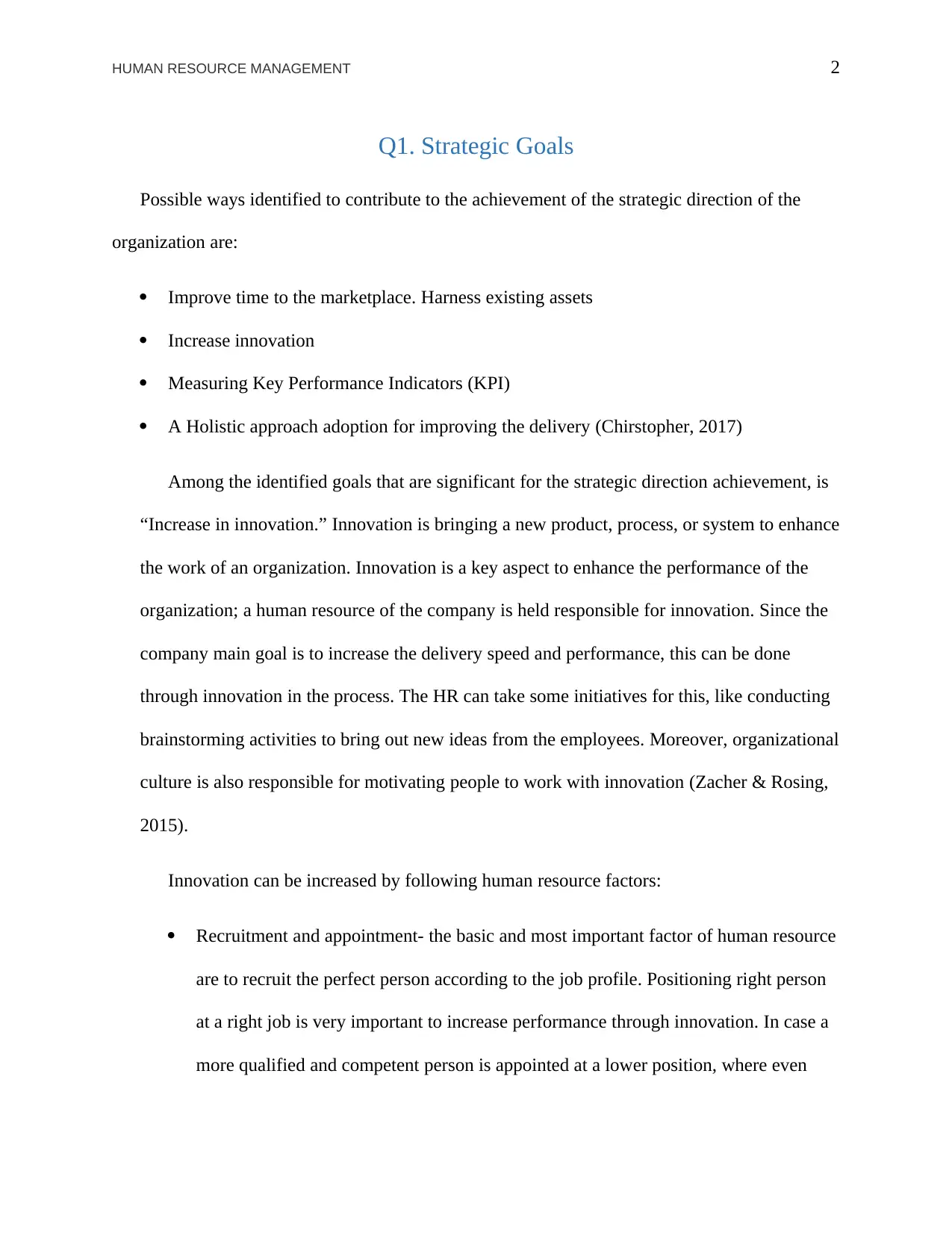
HUMAN RESOURCE MANAGEMENT 2
Q1. Strategic Goals
Possible ways identified to contribute to the achievement of the strategic direction of the
organization are:
Improve time to the marketplace. Harness existing assets
Increase innovation
Measuring Key Performance Indicators (KPI)
A Holistic approach adoption for improving the delivery (Chirstopher, 2017)
Among the identified goals that are significant for the strategic direction achievement, is
“Increase in innovation.” Innovation is bringing a new product, process, or system to enhance
the work of an organization. Innovation is a key aspect to enhance the performance of the
organization; a human resource of the company is held responsible for innovation. Since the
company main goal is to increase the delivery speed and performance, this can be done
through innovation in the process. The HR can take some initiatives for this, like conducting
brainstorming activities to bring out new ideas from the employees. Moreover, organizational
culture is also responsible for motivating people to work with innovation (Zacher & Rosing,
2015).
Innovation can be increased by following human resource factors:
Recruitment and appointment- the basic and most important factor of human resource
are to recruit the perfect person according to the job profile. Positioning right person
at a right job is very important to increase performance through innovation. In case a
more qualified and competent person is appointed at a lower position, where even
Q1. Strategic Goals
Possible ways identified to contribute to the achievement of the strategic direction of the
organization are:
Improve time to the marketplace. Harness existing assets
Increase innovation
Measuring Key Performance Indicators (KPI)
A Holistic approach adoption for improving the delivery (Chirstopher, 2017)
Among the identified goals that are significant for the strategic direction achievement, is
“Increase in innovation.” Innovation is bringing a new product, process, or system to enhance
the work of an organization. Innovation is a key aspect to enhance the performance of the
organization; a human resource of the company is held responsible for innovation. Since the
company main goal is to increase the delivery speed and performance, this can be done
through innovation in the process. The HR can take some initiatives for this, like conducting
brainstorming activities to bring out new ideas from the employees. Moreover, organizational
culture is also responsible for motivating people to work with innovation (Zacher & Rosing,
2015).
Innovation can be increased by following human resource factors:
Recruitment and appointment- the basic and most important factor of human resource
are to recruit the perfect person according to the job profile. Positioning right person
at a right job is very important to increase performance through innovation. In case a
more qualified and competent person is appointed at a lower position, where even
⊘ This is a preview!⊘
Do you want full access?
Subscribe today to unlock all pages.

Trusted by 1+ million students worldwide
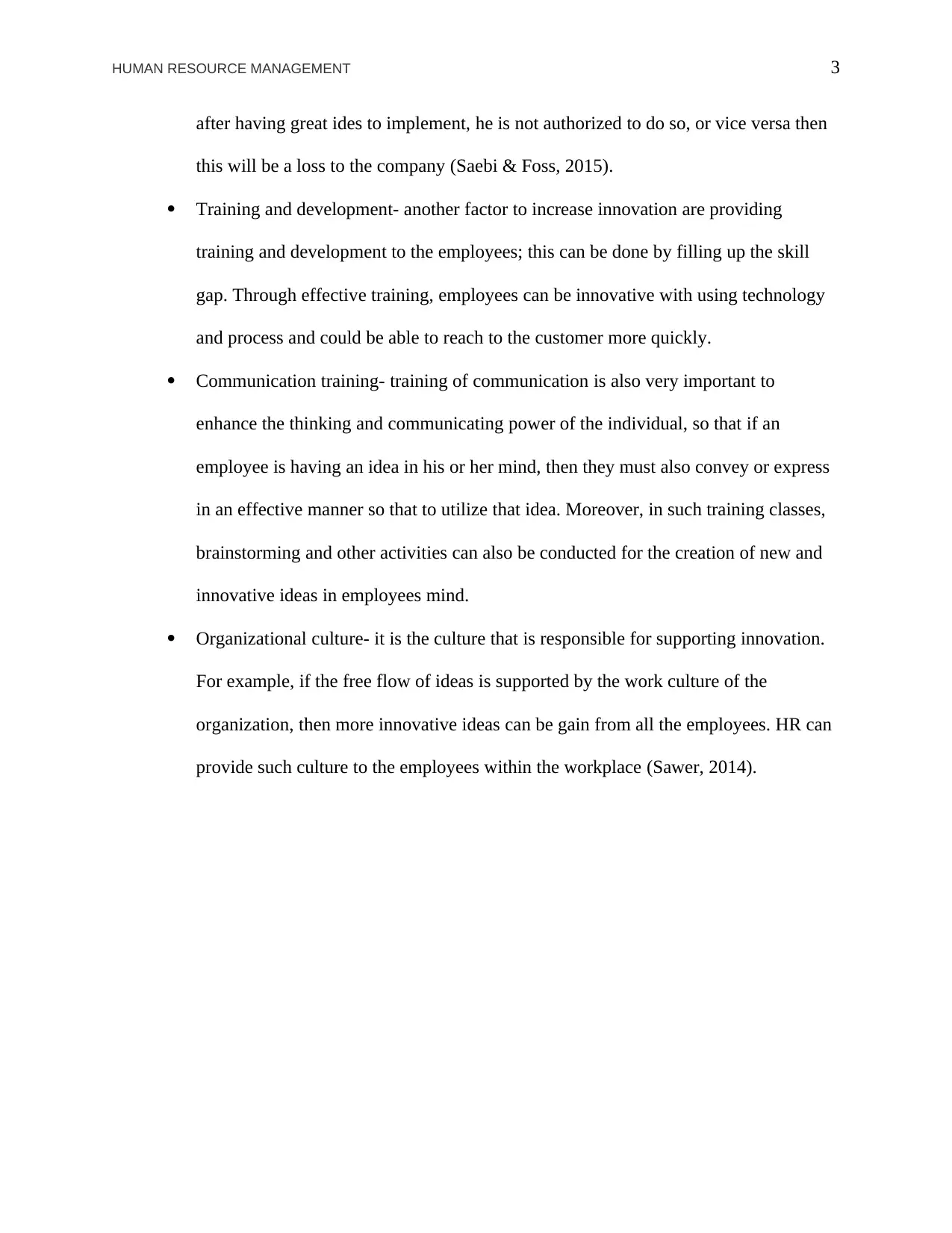
HUMAN RESOURCE MANAGEMENT 3
after having great ides to implement, he is not authorized to do so, or vice versa then
this will be a loss to the company (Saebi & Foss, 2015).
Training and development- another factor to increase innovation are providing
training and development to the employees; this can be done by filling up the skill
gap. Through effective training, employees can be innovative with using technology
and process and could be able to reach to the customer more quickly.
Communication training- training of communication is also very important to
enhance the thinking and communicating power of the individual, so that if an
employee is having an idea in his or her mind, then they must also convey or express
in an effective manner so that to utilize that idea. Moreover, in such training classes,
brainstorming and other activities can also be conducted for the creation of new and
innovative ideas in employees mind.
Organizational culture- it is the culture that is responsible for supporting innovation.
For example, if the free flow of ideas is supported by the work culture of the
organization, then more innovative ideas can be gain from all the employees. HR can
provide such culture to the employees within the workplace (Sawer, 2014).
after having great ides to implement, he is not authorized to do so, or vice versa then
this will be a loss to the company (Saebi & Foss, 2015).
Training and development- another factor to increase innovation are providing
training and development to the employees; this can be done by filling up the skill
gap. Through effective training, employees can be innovative with using technology
and process and could be able to reach to the customer more quickly.
Communication training- training of communication is also very important to
enhance the thinking and communicating power of the individual, so that if an
employee is having an idea in his or her mind, then they must also convey or express
in an effective manner so that to utilize that idea. Moreover, in such training classes,
brainstorming and other activities can also be conducted for the creation of new and
innovative ideas in employees mind.
Organizational culture- it is the culture that is responsible for supporting innovation.
For example, if the free flow of ideas is supported by the work culture of the
organization, then more innovative ideas can be gain from all the employees. HR can
provide such culture to the employees within the workplace (Sawer, 2014).
Paraphrase This Document
Need a fresh take? Get an instant paraphrase of this document with our AI Paraphraser
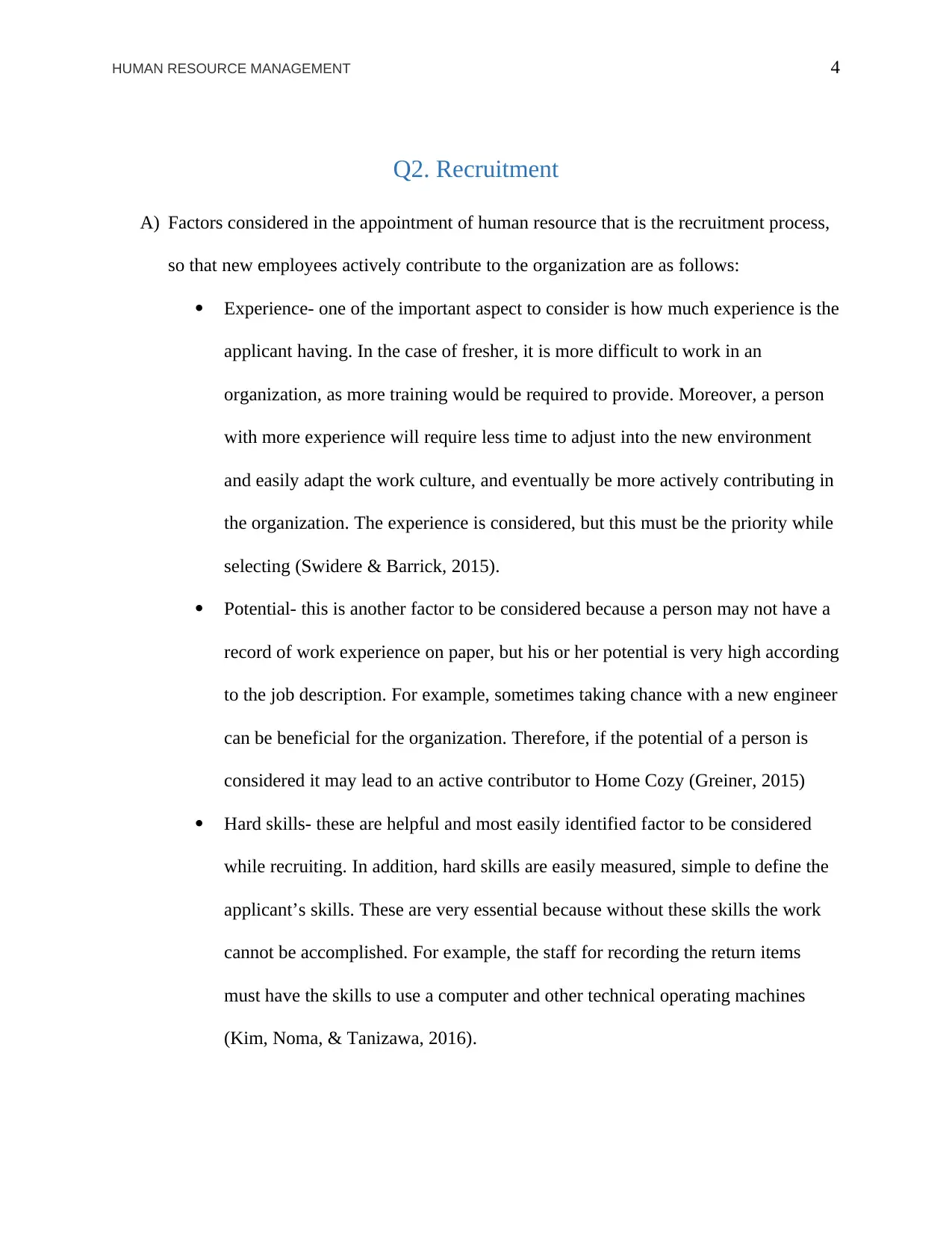
HUMAN RESOURCE MANAGEMENT 4
Q2. Recruitment
A) Factors considered in the appointment of human resource that is the recruitment process,
so that new employees actively contribute to the organization are as follows:
Experience- one of the important aspect to consider is how much experience is the
applicant having. In the case of fresher, it is more difficult to work in an
organization, as more training would be required to provide. Moreover, a person
with more experience will require less time to adjust into the new environment
and easily adapt the work culture, and eventually be more actively contributing in
the organization. The experience is considered, but this must be the priority while
selecting (Swidere & Barrick, 2015).
Potential- this is another factor to be considered because a person may not have a
record of work experience on paper, but his or her potential is very high according
to the job description. For example, sometimes taking chance with a new engineer
can be beneficial for the organization. Therefore, if the potential of a person is
considered it may lead to an active contributor to Home Cozy (Greiner, 2015)
Hard skills- these are helpful and most easily identified factor to be considered
while recruiting. In addition, hard skills are easily measured, simple to define the
applicant’s skills. These are very essential because without these skills the work
cannot be accomplished. For example, the staff for recording the return items
must have the skills to use a computer and other technical operating machines
(Kim, Noma, & Tanizawa, 2016).
Q2. Recruitment
A) Factors considered in the appointment of human resource that is the recruitment process,
so that new employees actively contribute to the organization are as follows:
Experience- one of the important aspect to consider is how much experience is the
applicant having. In the case of fresher, it is more difficult to work in an
organization, as more training would be required to provide. Moreover, a person
with more experience will require less time to adjust into the new environment
and easily adapt the work culture, and eventually be more actively contributing in
the organization. The experience is considered, but this must be the priority while
selecting (Swidere & Barrick, 2015).
Potential- this is another factor to be considered because a person may not have a
record of work experience on paper, but his or her potential is very high according
to the job description. For example, sometimes taking chance with a new engineer
can be beneficial for the organization. Therefore, if the potential of a person is
considered it may lead to an active contributor to Home Cozy (Greiner, 2015)
Hard skills- these are helpful and most easily identified factor to be considered
while recruiting. In addition, hard skills are easily measured, simple to define the
applicant’s skills. These are very essential because without these skills the work
cannot be accomplished. For example, the staff for recording the return items
must have the skills to use a computer and other technical operating machines
(Kim, Noma, & Tanizawa, 2016).
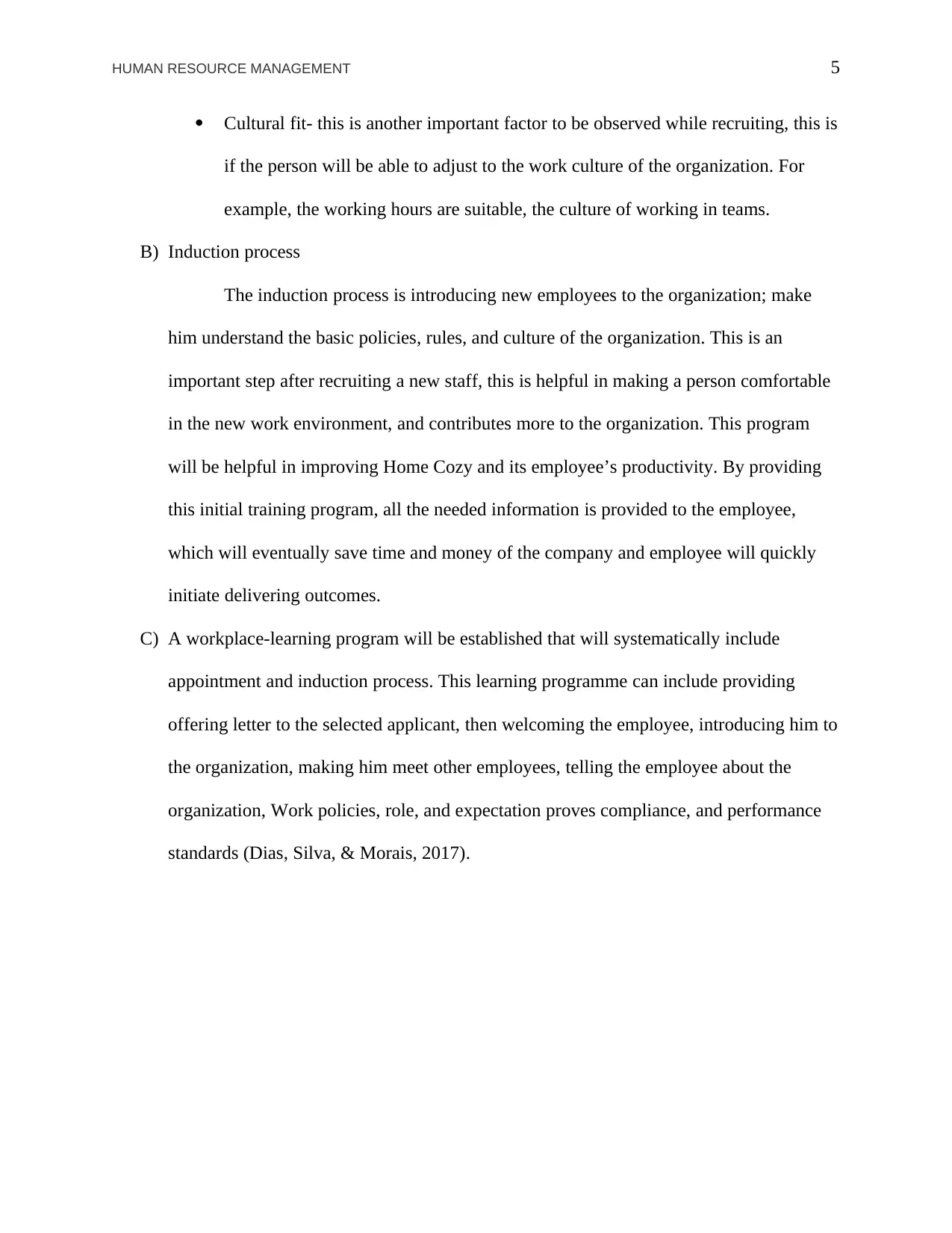
HUMAN RESOURCE MANAGEMENT 5
Cultural fit- this is another important factor to be observed while recruiting, this is
if the person will be able to adjust to the work culture of the organization. For
example, the working hours are suitable, the culture of working in teams.
B) Induction process
The induction process is introducing new employees to the organization; make
him understand the basic policies, rules, and culture of the organization. This is an
important step after recruiting a new staff, this is helpful in making a person comfortable
in the new work environment, and contributes more to the organization. This program
will be helpful in improving Home Cozy and its employee’s productivity. By providing
this initial training program, all the needed information is provided to the employee,
which will eventually save time and money of the company and employee will quickly
initiate delivering outcomes.
C) A workplace-learning program will be established that will systematically include
appointment and induction process. This learning programme can include providing
offering letter to the selected applicant, then welcoming the employee, introducing him to
the organization, making him meet other employees, telling the employee about the
organization, Work policies, role, and expectation proves compliance, and performance
standards (Dias, Silva, & Morais, 2017).
Cultural fit- this is another important factor to be observed while recruiting, this is
if the person will be able to adjust to the work culture of the organization. For
example, the working hours are suitable, the culture of working in teams.
B) Induction process
The induction process is introducing new employees to the organization; make
him understand the basic policies, rules, and culture of the organization. This is an
important step after recruiting a new staff, this is helpful in making a person comfortable
in the new work environment, and contributes more to the organization. This program
will be helpful in improving Home Cozy and its employee’s productivity. By providing
this initial training program, all the needed information is provided to the employee,
which will eventually save time and money of the company and employee will quickly
initiate delivering outcomes.
C) A workplace-learning program will be established that will systematically include
appointment and induction process. This learning programme can include providing
offering letter to the selected applicant, then welcoming the employee, introducing him to
the organization, making him meet other employees, telling the employee about the
organization, Work policies, role, and expectation proves compliance, and performance
standards (Dias, Silva, & Morais, 2017).
⊘ This is a preview!⊘
Do you want full access?
Subscribe today to unlock all pages.

Trusted by 1+ million students worldwide
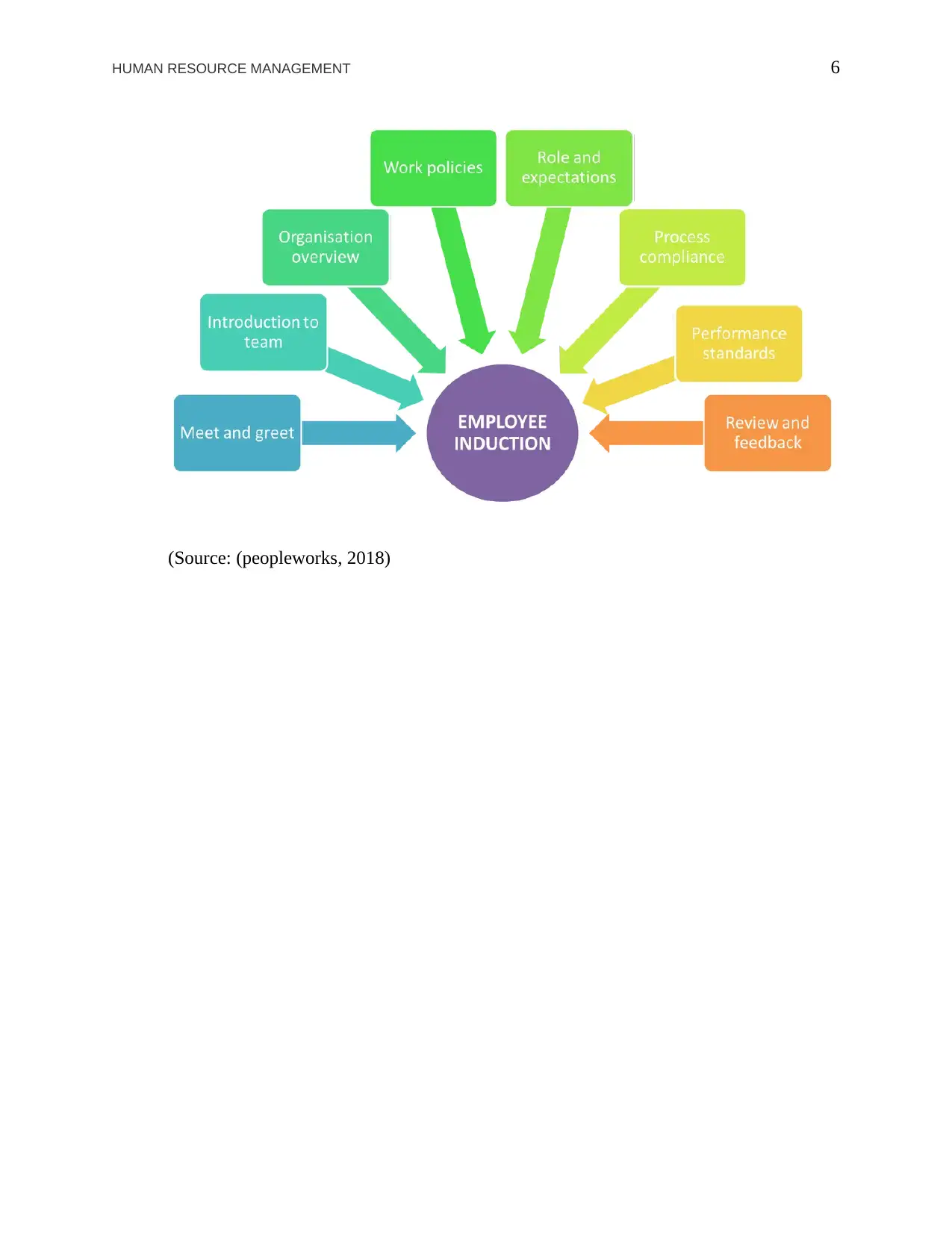
HUMAN RESOURCE MANAGEMENT 6
(Source: (peopleworks, 2018)
(Source: (peopleworks, 2018)
Paraphrase This Document
Need a fresh take? Get an instant paraphrase of this document with our AI Paraphraser
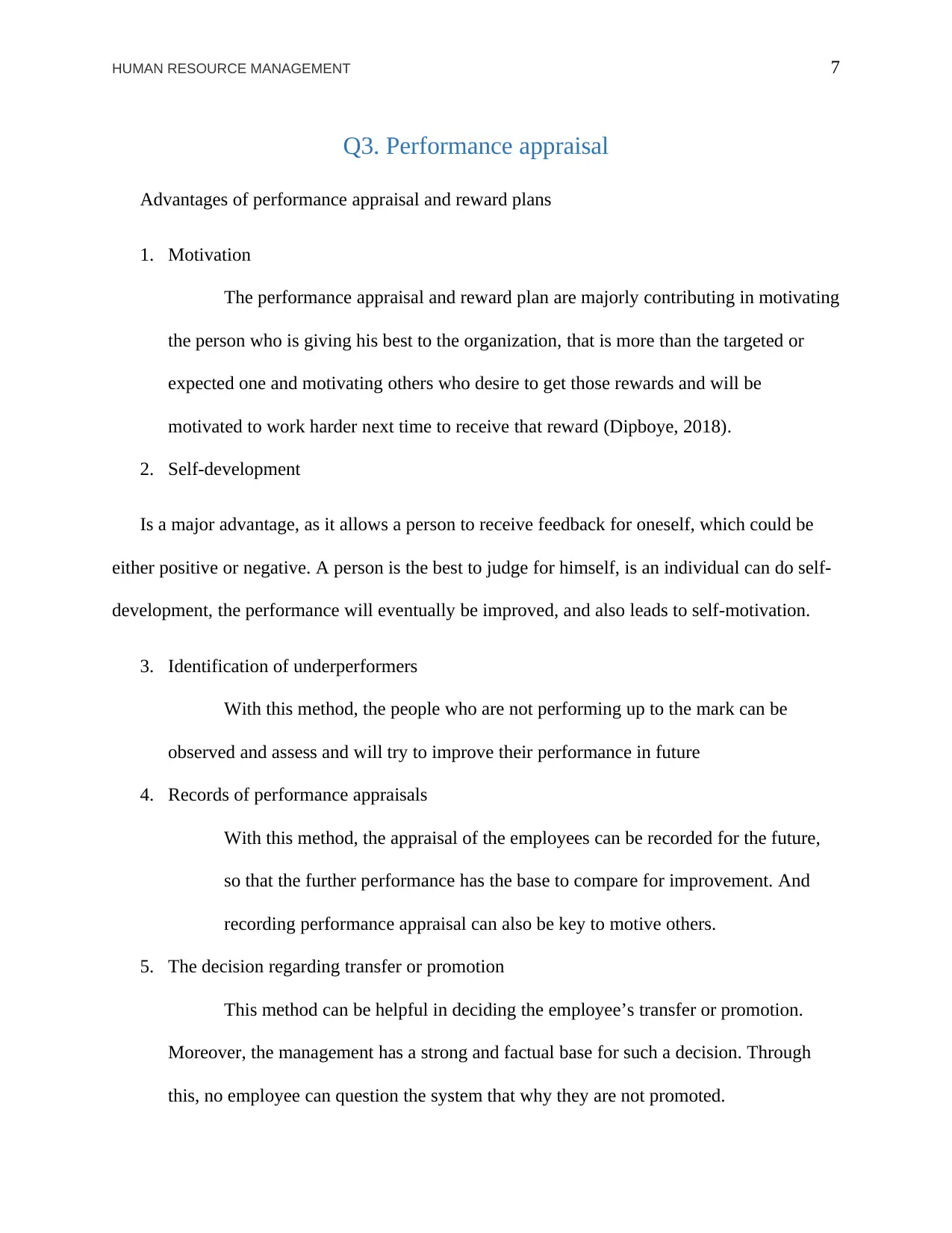
HUMAN RESOURCE MANAGEMENT 7
Q3. Performance appraisal
Advantages of performance appraisal and reward plans
1. Motivation
The performance appraisal and reward plan are majorly contributing in motivating
the person who is giving his best to the organization, that is more than the targeted or
expected one and motivating others who desire to get those rewards and will be
motivated to work harder next time to receive that reward (Dipboye, 2018).
2. Self-development
Is a major advantage, as it allows a person to receive feedback for oneself, which could be
either positive or negative. A person is the best to judge for himself, is an individual can do self-
development, the performance will eventually be improved, and also leads to self-motivation.
3. Identification of underperformers
With this method, the people who are not performing up to the mark can be
observed and assess and will try to improve their performance in future
4. Records of performance appraisals
With this method, the appraisal of the employees can be recorded for the future,
so that the further performance has the base to compare for improvement. And
recording performance appraisal can also be key to motive others.
5. The decision regarding transfer or promotion
This method can be helpful in deciding the employee’s transfer or promotion.
Moreover, the management has a strong and factual base for such a decision. Through
this, no employee can question the system that why they are not promoted.
Q3. Performance appraisal
Advantages of performance appraisal and reward plans
1. Motivation
The performance appraisal and reward plan are majorly contributing in motivating
the person who is giving his best to the organization, that is more than the targeted or
expected one and motivating others who desire to get those rewards and will be
motivated to work harder next time to receive that reward (Dipboye, 2018).
2. Self-development
Is a major advantage, as it allows a person to receive feedback for oneself, which could be
either positive or negative. A person is the best to judge for himself, is an individual can do self-
development, the performance will eventually be improved, and also leads to self-motivation.
3. Identification of underperformers
With this method, the people who are not performing up to the mark can be
observed and assess and will try to improve their performance in future
4. Records of performance appraisals
With this method, the appraisal of the employees can be recorded for the future,
so that the further performance has the base to compare for improvement. And
recording performance appraisal can also be key to motive others.
5. The decision regarding transfer or promotion
This method can be helpful in deciding the employee’s transfer or promotion.
Moreover, the management has a strong and factual base for such a decision. Through
this, no employee can question the system that why they are not promoted.
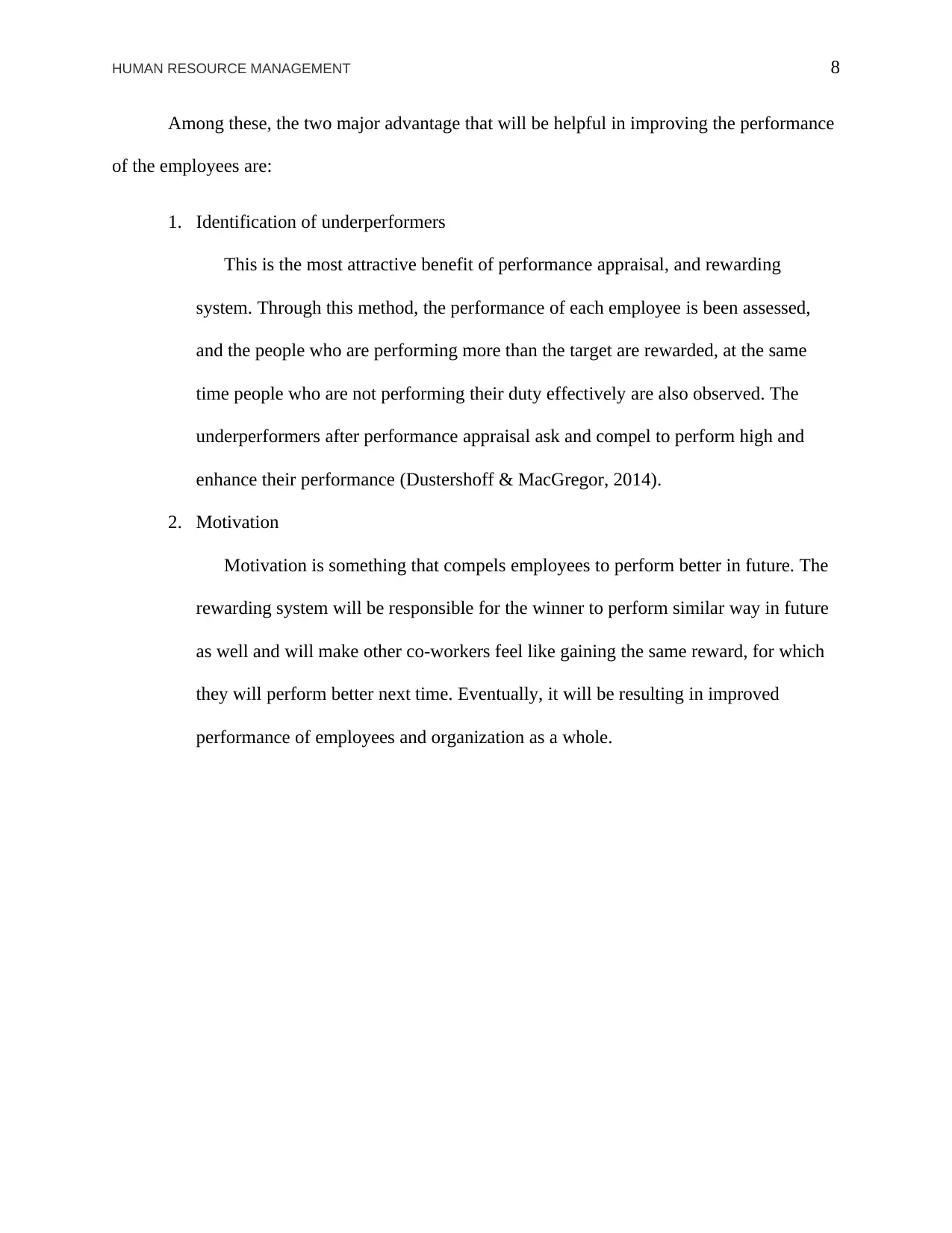
HUMAN RESOURCE MANAGEMENT 8
Among these, the two major advantage that will be helpful in improving the performance
of the employees are:
1. Identification of underperformers
This is the most attractive benefit of performance appraisal, and rewarding
system. Through this method, the performance of each employee is been assessed,
and the people who are performing more than the target are rewarded, at the same
time people who are not performing their duty effectively are also observed. The
underperformers after performance appraisal ask and compel to perform high and
enhance their performance (Dustershoff & MacGregor, 2014).
2. Motivation
Motivation is something that compels employees to perform better in future. The
rewarding system will be responsible for the winner to perform similar way in future
as well and will make other co-workers feel like gaining the same reward, for which
they will perform better next time. Eventually, it will be resulting in improved
performance of employees and organization as a whole.
Among these, the two major advantage that will be helpful in improving the performance
of the employees are:
1. Identification of underperformers
This is the most attractive benefit of performance appraisal, and rewarding
system. Through this method, the performance of each employee is been assessed,
and the people who are performing more than the target are rewarded, at the same
time people who are not performing their duty effectively are also observed. The
underperformers after performance appraisal ask and compel to perform high and
enhance their performance (Dustershoff & MacGregor, 2014).
2. Motivation
Motivation is something that compels employees to perform better in future. The
rewarding system will be responsible for the winner to perform similar way in future
as well and will make other co-workers feel like gaining the same reward, for which
they will perform better next time. Eventually, it will be resulting in improved
performance of employees and organization as a whole.
⊘ This is a preview!⊘
Do you want full access?
Subscribe today to unlock all pages.

Trusted by 1+ million students worldwide

HUMAN RESOURCE MANAGEMENT 9
Q4. Performance-based pay
This system of Home Cozy that is the “performance-based pay,” as a reward system is
very effective for the organization and individual employee. With the consent of staff, that is
formally conducted, this system was introduced and informed through debate. According to this
method, it will be initiated with training grade, and then eventually gain up to the eight-grade pay
scale, as per the performance of an individual in an organization. The performance level of each
individual is then stored in the system, which will allocate the work automatically to the
employees as per their grade. This system is very effective, as this will motivate employees to
perform well and increase their grade to enhance their pay. Moreover, the system is set with the
consent of all employees, so they do not resist the system or any change occurs (Brown, Kaine,
& Shields, 2015).
A recommended reward system to improve the performance of staff:
1. A winning system with an Incentive plan
According to this system, the reward is based on two factors, behavior, and
employee activity performance. This will ensure that the performance is been improved,
but this is not the result of poor or unethical behaviors or the undue influence of the
employee. The incentive plan could be prepared to identify top performing employees of
the organization along with the behavior of that individual. Moreover, some particular
behavior must be rewarded that will make difference to the organization. For example,
discipline, that is the timely completion of work, punctuality in coming and leaving the
workplace (Fang & Gerhart, 2014).
2. Strategic reward system
Q4. Performance-based pay
This system of Home Cozy that is the “performance-based pay,” as a reward system is
very effective for the organization and individual employee. With the consent of staff, that is
formally conducted, this system was introduced and informed through debate. According to this
method, it will be initiated with training grade, and then eventually gain up to the eight-grade pay
scale, as per the performance of an individual in an organization. The performance level of each
individual is then stored in the system, which will allocate the work automatically to the
employees as per their grade. This system is very effective, as this will motivate employees to
perform well and increase their grade to enhance their pay. Moreover, the system is set with the
consent of all employees, so they do not resist the system or any change occurs (Brown, Kaine,
& Shields, 2015).
A recommended reward system to improve the performance of staff:
1. A winning system with an Incentive plan
According to this system, the reward is based on two factors, behavior, and
employee activity performance. This will ensure that the performance is been improved,
but this is not the result of poor or unethical behaviors or the undue influence of the
employee. The incentive plan could be prepared to identify top performing employees of
the organization along with the behavior of that individual. Moreover, some particular
behavior must be rewarded that will make difference to the organization. For example,
discipline, that is the timely completion of work, punctuality in coming and leaving the
workplace (Fang & Gerhart, 2014).
2. Strategic reward system
Paraphrase This Document
Need a fresh take? Get an instant paraphrase of this document with our AI Paraphraser
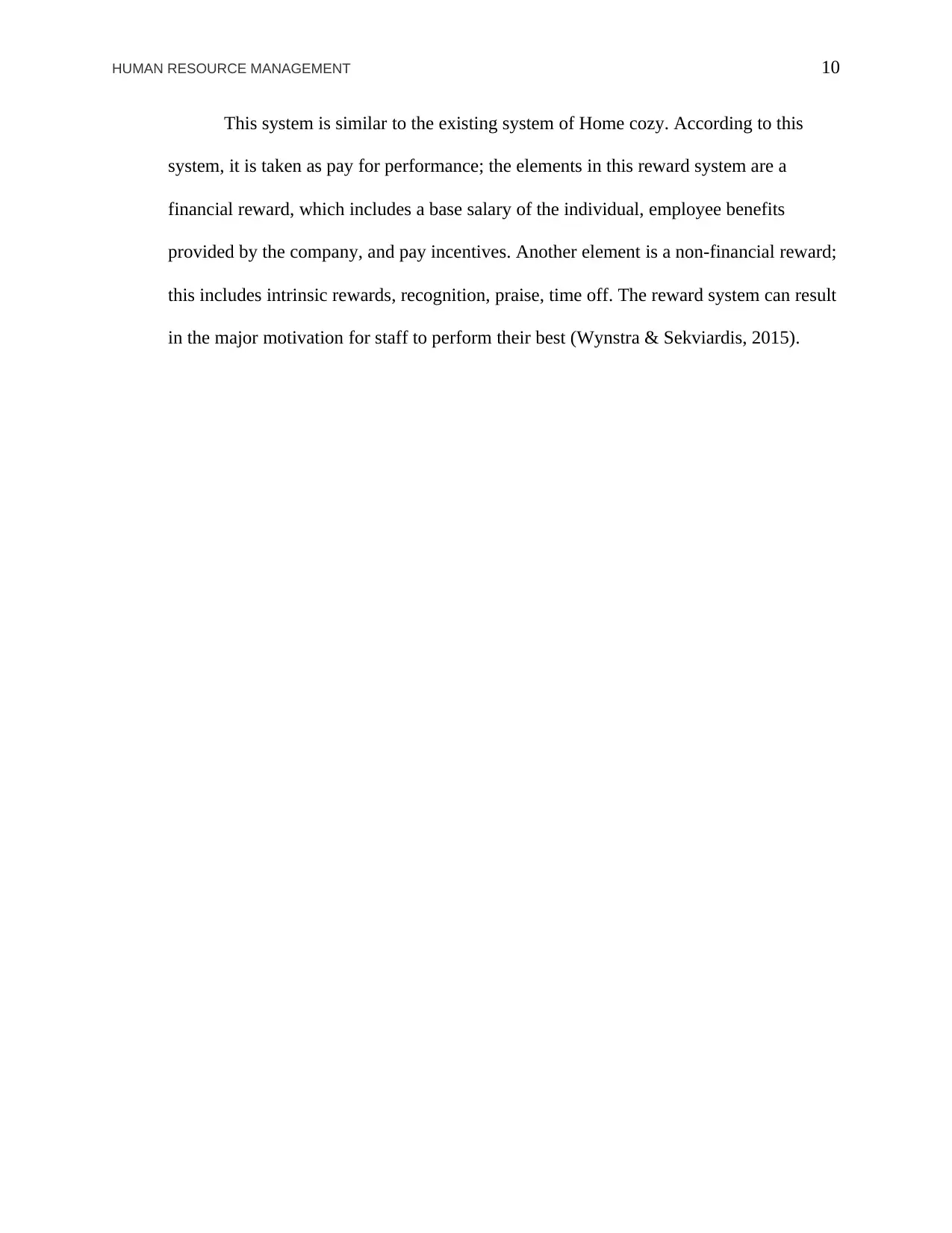
HUMAN RESOURCE MANAGEMENT 10
This system is similar to the existing system of Home cozy. According to this
system, it is taken as pay for performance; the elements in this reward system are a
financial reward, which includes a base salary of the individual, employee benefits
provided by the company, and pay incentives. Another element is a non-financial reward;
this includes intrinsic rewards, recognition, praise, time off. The reward system can result
in the major motivation for staff to perform their best (Wynstra & Sekviardis, 2015).
This system is similar to the existing system of Home cozy. According to this
system, it is taken as pay for performance; the elements in this reward system are a
financial reward, which includes a base salary of the individual, employee benefits
provided by the company, and pay incentives. Another element is a non-financial reward;
this includes intrinsic rewards, recognition, praise, time off. The reward system can result
in the major motivation for staff to perform their best (Wynstra & Sekviardis, 2015).
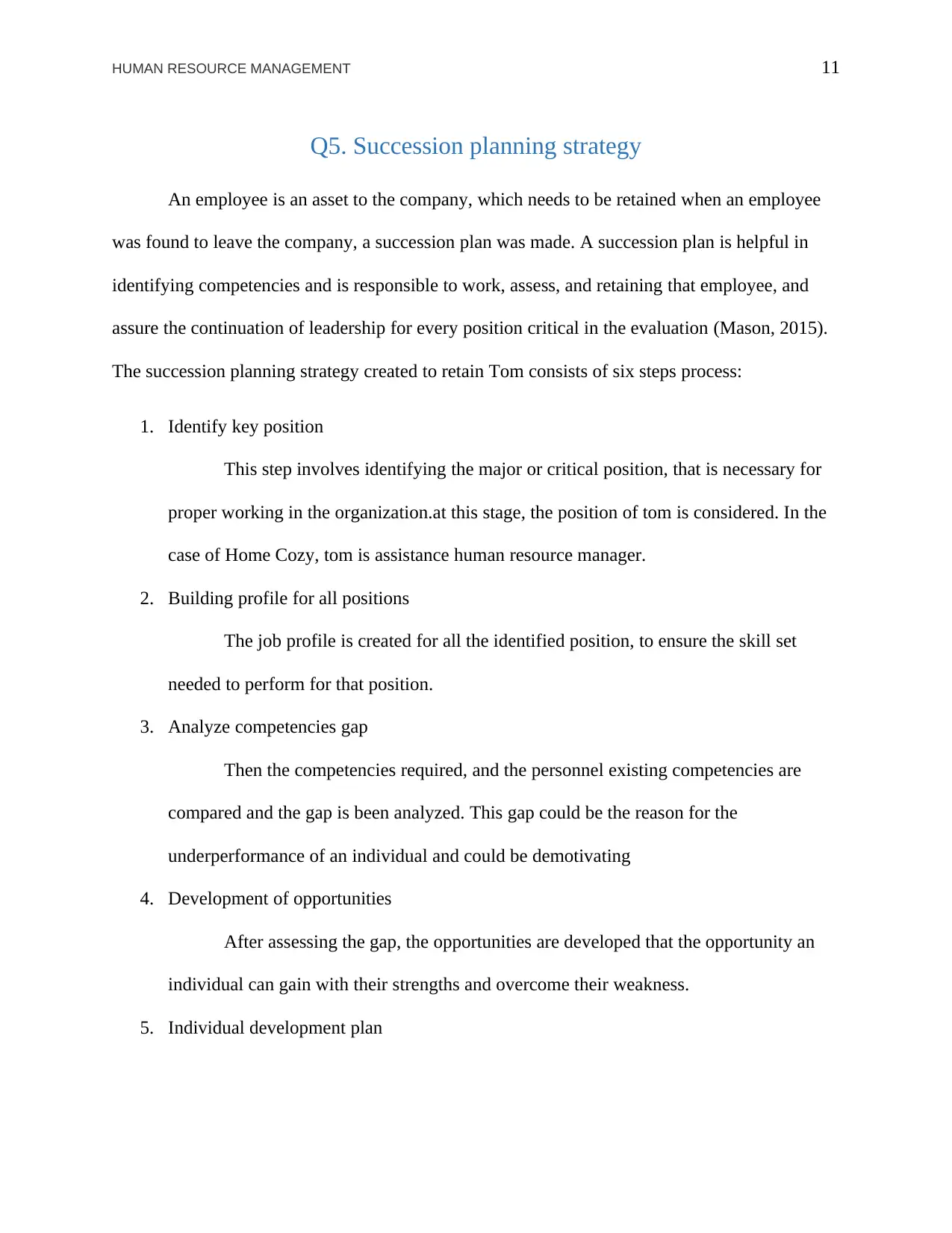
HUMAN RESOURCE MANAGEMENT 11
Q5. Succession planning strategy
An employee is an asset to the company, which needs to be retained when an employee
was found to leave the company, a succession plan was made. A succession plan is helpful in
identifying competencies and is responsible to work, assess, and retaining that employee, and
assure the continuation of leadership for every position critical in the evaluation (Mason, 2015).
The succession planning strategy created to retain Tom consists of six steps process:
1. Identify key position
This step involves identifying the major or critical position, that is necessary for
proper working in the organization.at this stage, the position of tom is considered. In the
case of Home Cozy, tom is assistance human resource manager.
2. Building profile for all positions
The job profile is created for all the identified position, to ensure the skill set
needed to perform for that position.
3. Analyze competencies gap
Then the competencies required, and the personnel existing competencies are
compared and the gap is been analyzed. This gap could be the reason for the
underperformance of an individual and could be demotivating
4. Development of opportunities
After assessing the gap, the opportunities are developed that the opportunity an
individual can gain with their strengths and overcome their weakness.
5. Individual development plan
Q5. Succession planning strategy
An employee is an asset to the company, which needs to be retained when an employee
was found to leave the company, a succession plan was made. A succession plan is helpful in
identifying competencies and is responsible to work, assess, and retaining that employee, and
assure the continuation of leadership for every position critical in the evaluation (Mason, 2015).
The succession planning strategy created to retain Tom consists of six steps process:
1. Identify key position
This step involves identifying the major or critical position, that is necessary for
proper working in the organization.at this stage, the position of tom is considered. In the
case of Home Cozy, tom is assistance human resource manager.
2. Building profile for all positions
The job profile is created for all the identified position, to ensure the skill set
needed to perform for that position.
3. Analyze competencies gap
Then the competencies required, and the personnel existing competencies are
compared and the gap is been analyzed. This gap could be the reason for the
underperformance of an individual and could be demotivating
4. Development of opportunities
After assessing the gap, the opportunities are developed that the opportunity an
individual can gain with their strengths and overcome their weakness.
5. Individual development plan
⊘ This is a preview!⊘
Do you want full access?
Subscribe today to unlock all pages.

Trusted by 1+ million students worldwide
1 out of 24
Related Documents
Your All-in-One AI-Powered Toolkit for Academic Success.
+13062052269
info@desklib.com
Available 24*7 on WhatsApp / Email
![[object Object]](/_next/static/media/star-bottom.7253800d.svg)
Unlock your academic potential
Copyright © 2020–2025 A2Z Services. All Rights Reserved. Developed and managed by ZUCOL.





